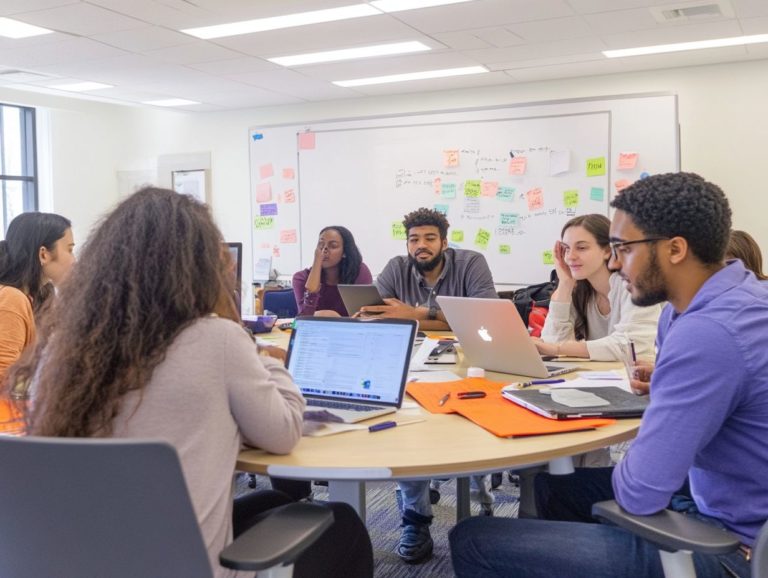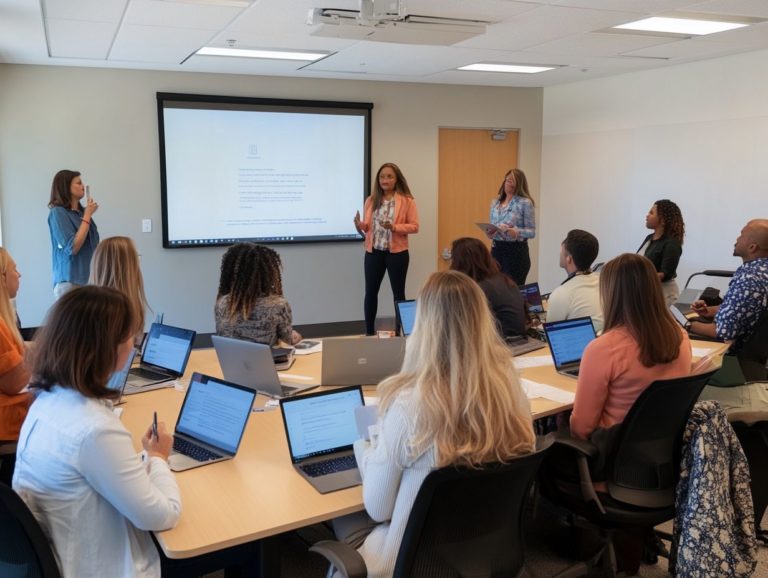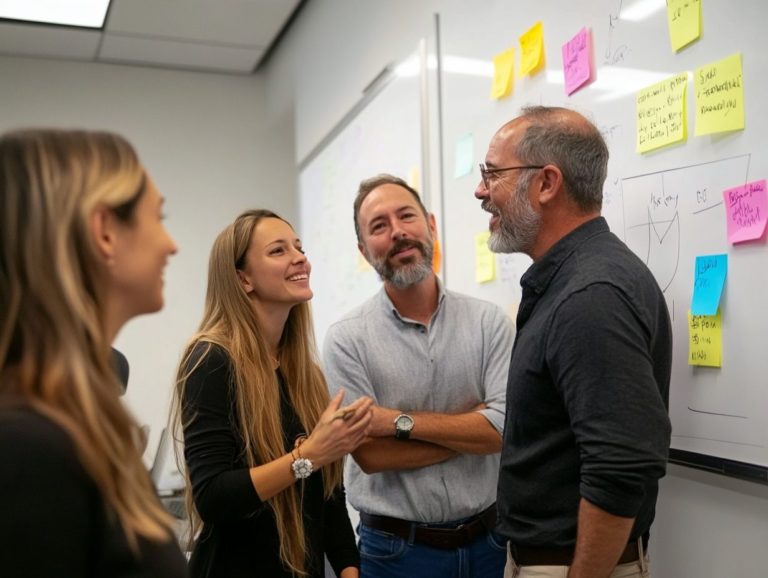The Role of Feedback in Skill Enhancement
Feedback is essential for enhancing your skills and guiding your growth across various fields. By understanding its significance, you can completely transform your approach to learning and self-improvement.
This article delves into the different types of feedback positive versus negative, formative versus summative and offers effective strategies for both giving and receiving feedback. With real-life examples and case studies, discover how feedback can dramatically change your career!
Explore with us the vital role feedback plays in elevating your skills to new heights.
Contents
- Key Takeaways:
- Understanding Feedback in Skill Enhancement
- Types of Feedback
- Effective Strategies for Giving and Receiving Feedback
- The Impact of Feedback on Skill Enhancement
- Frequently Asked Questions
- What is the role of feedback in skill enhancement?
- How does feedback help in improving skills?
- What are the different types of feedback that can aid in skill enhancement?
- Is feedback always necessary for skill enhancement?
- Can negative feedback hinder skill enhancement?
- How can one effectively use feedback for skill enhancement?
Key Takeaways:

- Feedback is an essential tool for improving skills, providing valuable insights and opportunities for growth.
- Different types of feedback, including positive, negative, formative, and summative, each serve a unique purpose in skill enhancement.
- To effectively utilize feedback for skill enhancement, give and receive feedback constructively, using it as a learning opportunity rather than criticism.
Understanding Feedback in Skill Enhancement
Understanding feedback in skill enhancement is essential for any organization striving to create a learning environment among its employees. Feedback acts as a powerful catalyst for professional growth, sharpening communication skills and fostering continuous improvement across training programs.
It offers actionable insights and enables organizations, such as Meraqui and Talent Sapphire Pvt. Ltd., to assess employee performance with precision. By weaving constructive and positive feedback into performance reviews, companies can elevate employee engagement and retention. This creates avenues for career advancement and heightened productivity.
What is Feedback?
Feedback is a structured communication process designed to enhance your learning experience by offering insights into your performance, strengths, and areas for improvement within the organization.
It s not just a tool for personal growth; it s essential for creating a collaborative environment where you feel valued and enabled. Various forms of feedback whether formative, summative, peer-to-peer, or through self-assessment play a crucial role in driving your engagement and productivity.
When delivered thoughtfully, constructive feedback encourages you to build on your skills and stay aligned with the organization’s goals. This process not only supports your development but also fosters a positive organizational culture marked by open communication, trust, and continuous improvement. This leads to higher satisfaction and retention rates among employees.
The Importance of Feedback in Skill Development
The importance of feedback in skill development cannot be overstated; it serves as a crucial way to improve your skills, fostering your professional growth and nurturing your self-awareness.
When you receive constructive feedback, you gain valuable insights into your strengths and areas for improvement, allowing you to refine your skills more effectively. This ongoing dialogue cultivates a culture of continuous learning and inspires you to strive for excellence in your role.
Organizations that prioritize feedback mechanisms often witness a significant boost in engagement levels, as you and your colleagues feel supported and valued on your development journeys.
By incorporating regular feedback loops, a dynamic environment emerges one where adaptability and resilience become woven into the fabric of the corporate ethos, ultimately driving collective success.
Types of Feedback

Organizations employ various types of feedback to elevate employee performance, including:
- Constructive Feedback
- Positive Feedback
- 360-Degree Feedback (which involves gathering input from all levels of an organization, including peers and superiors)
Each of these serves a unique role in the development process, contributing to a well-rounded approach to growth and improvement.
Positive vs. Negative Feedback
Positive feedback reinforces the behaviors and achievements you wish to see, while negative feedback highlights areas that need improvement. Both play integral roles in your development and growth as an employee.
Effective communication within organizations often hinges on striking a harmonious balance between these two types of feedback. When you receive consistent recognition for your strong performance, it significantly boosts your morale and encourages you to maintain or even elevate your commitment to your work.
On the flip side, helpful feedback, while sometimes tough to swallow, provides invaluable insights that can guide your personal and professional improvement. Organizations that value both kinds of feedback experience enhanced collaboration, greater employee satisfaction, and ultimately, higher productivity levels.
Striking this balance supports your individual performance and fosters a vibrant culture of continuous learning and engagement.
Formative vs. Summative Feedback
Ongoing guidance during learning plays a vital role during your learning process, offering continuous support. In contrast, summative feedback arrives after a performance review, summarizing your overall achievements and identifying areas for growth.
This dual approach is essential in training programs, enabling you to reflect, adapt, and implement necessary improvements in real time. Formative feedback focuses on skill development, helping you navigate challenges while reinforcing your learning objectives. On the other hand, summative feedback provides a conclusive assessment, encapsulating your journey and highlighting key milestones.
Together, these feedback types significantly enhance your learning experience and foster a culture of continuous improvement and professional development essential elements in today s ever-evolving workplace. Ultimately, integrating both formative and summative feedback can lead to more engaged employees and improved organizational outcomes.
Effective Strategies for Giving and Receiving Feedback
Implementing effective strategies for giving and receiving feedback is essential for cultivating an environment ripe for growth and development within organizations. This enhances communication skills and significantly boosts overall employee performance.
Tips for Giving Constructive Feedback

Providing constructive feedback requires a thoughtful approach that emphasizes specific behaviors rather than personal traits, all while nurturing a supportive feedback culture within your organization.
To achieve this, it’s crucial to cultivate an environment where employees feel safe receiving and acting on feedback. Adopting a calm and encouraging tone can significantly influence how your message is received. Timeliness is key offering feedback promptly after an event ensures that it remains relevant and clear.
By framing conversations around growth opportunities instead of merely highlighting flaws, you can inspire individuals to improve. Engaging in a collaborative dialogue enhances understanding and fosters a culture of ongoing development, making feedback a shared journey rather than a one-sided critique.
How to Receive Feedback and Use it for Improvement
Receiving feedback with grace and leveraging it for improvement is vital for both personal and professional growth. It nurtures self-awareness and encourages a proactive learning approach.
To truly benefit from feedback, cultivate an open mindset that sees criticism as an opportunity rather than a setback. Recognizing that everyone has room for improvement can transform the experience into a powerful tool for your development. Actively seek constructive input by creating a safe space for honest dialogue and being willing to ask specific questions.
Implementing strategies like summarizing the feedback you receive or developing an action plan clarifies any misunderstandings and reinforces your commitment to growth. Ultimately, embracing feedback enhances your skills and deepens your understanding of your strengths and weaknesses.
The Impact of Feedback on Skill Enhancement
The impact of feedback on skill enhancement is truly remarkable. It shapes not only your individual performance and productivity, but also plays a vital role in employee retention and fostering innovation within organizations.
Embrace feedback today and unlock your potential!
Real-Life Examples and Case Studies
Real-life examples and case studies vividly illustrate how effective feedback mechanisms can revolutionize performance and employee development across various organizations.
Take Google, for instance. Their innovative ‘Project Oxygen’ centered on gathering employee feedback to refine managerial practices. This initiative uncovered that effective managers play a crucial role in employee satisfaction and performance.
As Google rolled out structured feedback loops, they witnessed a measurable uptick in employee engagement and retention rates.
Companies like Adobe have also adopted ‘Check-In’ sessions. These replace the outdated performance review model with ongoing discussions focused on goals and professional growth.
This approach has led to greater clarity in roles and a remarkable boost in productivity.
These exciting studies show that effective feedback systems can transform workplaces, cultivating a positive work culture and significantly enhancing overall organizational success.
Frequently Asked Questions

What is the role of feedback in skill enhancement?
Feedback plays a crucial role in skill enhancement by providing individuals with information on their performance and areas for improvement.
How does feedback help in improving skills?
Feedback helps individuals understand their strengths and weaknesses. This allows them to focus on areas that require improvement and ultimately enhance their skills.
What are the different types of feedback that can aid in skill enhancement?
There are two types of feedback that can help in skill enhancement: positive feedback that reinforces desired behaviors and constructive feedback that highlights areas for improvement.
Is feedback always necessary for skill enhancement?
While feedback can greatly aid in skill enhancement, it is not always necessary. Some individuals may be able to assess their own skills and improve without external feedback.
Can negative feedback hinder skill enhancement?
Negative feedback, especially when delivered in a harsh or unconstructive manner, can hinder skill enhancement. It may discourage individuals and make them less motivated to improve.
How can one effectively use feedback for skill enhancement?
To effectively use feedback for skill enhancement, individuals should be open to receiving it and actively listen to and reflect on it. They can then use it to set specific goals for improvement.
Start using feedback today to unlock your full potential!






